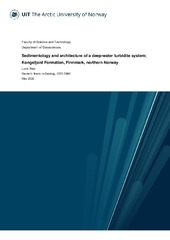Institutt for geovitenskap: Recent submissions
Now showing items 321-340 of 1121
-
Sedimentology and architecture of a deep-water turbidite system; Kongsfjord Formation, Finnmark, northern Norway
(Mastergradsoppgave; Master thesis, 2022-05-15)The Kongsfjord Formation is a Late Precambrian deep-marine sedimentary succession exposed along the northern coastline of the Varanger Peninsula, northern Norway. Several studies in the 1970s and 1980s led to the recognition of the Formation as an ancient submarine fan system and to the identification of several architectural elements, including lobes and channels. However, there are no published ... -
Upper cretaceous-paleogene stratigraphy and development of the Mímir High, Vøring transform margin, Norwegian Sea
(Journal article; Tidsskriftartikkel; Peer reviewed, 2020-09-19)Transform margins represent strike-slip type of plate boundaries that form during continental breakup and initial ocean opening. They are often characterized by margin-parallel highs with exposed pre- and syn-rift sequences. The Vøring Transform Margin, offshore mid-Norway, initiated in the earliest Eocene during the opening of the NE Atlantic. Here, 2D seismic reflection data reveal a transform ... -
A Phenomenographic Analysis Of Students’ Experience Of Geological Time
(Journal article; Tidsskriftartikkel; Peer reviewed, 2021-06-01)Geological time is by many geoscience instructors considered a threshold concept for geoscience students, being a central concept for how we experience geosceince phenomena that takes place on a spatio-temporal scale ranging from micro (e.g. cloud formation) to macro (e.g. plate tectonics). If one wishes to understand geoscience phenomena that goes beyond human perception, one must move from the ... -
The Use of Foraminiferal Geochemistry to Investigate Methane Seepage at the Svyatogor Ridge, Arctic Ocean
(Master thesis; Mastergradsoppgave, 2022-05-12)Methane is a greenhouse gas contributing to contemporaneous global warming, and seepage is one of the ways through which it migrates from the deep sedimentary basins, all the way up to the hydro- and atmosphere. The study of methane seepage is still young as scientists are yet to discover most seep sites as well as seep associated biological species. A record of past methane seepage can be derived ... -
A Quantitative Analysis of Seasonal and Regional Forcing on the Terminus of Store Glacier, Greenland, from High Resolution Photogrammetry
(Master thesis; Mastergradsoppgave, 2022-01-15)A quantitative analysis of seasonal and regional forcing on the terminus of Store Glacier, Greenland, from high resolution photogrammetry for the period between 10 May 2014 and 13 June 2014. Imagery is analyzed through ImGRAFT processing to create a detailed velocity and strain rate for the proglacial mélange and glacial terminus in order to investigate changes to glacial calving dynamics during ... -
The role of ocean and atmospheric dynamics in the marine-based collapse of the last Eurasian Ice Sheet
(Journal article; Tidsskriftartikkel; Peer reviewed, 2022-05-19)Information from former ice sheets may provide important context for understanding the response of today’s ice sheets to forcing mechanisms. Here we present a reconstruction of the last deglaciation of marine sectors of the Eurasian Ice Sheet, emphasising how the retreat of the Norwegian Channel and the Barents Sea ice streams led to separation of the British-Irish and Fennoscandian ice sheets at ... -
Permafrost in monitored unstable rock slopes in Norway-New insights from temperature and surface velocity measurements, geophysical surveying, and ground temperature modelling
(Journal article; Tidsskriftartikkel; Peer reviewed, 2022-02-01)The warming and subsequent degradation of mountain permafrost within alpine areas represent an important process influencing the stability of steep slopes and rock faces. The unstable and monitored slopes of Mannen (Møre and Romsdal county, southern Norway) and Gámanjunni-3 (Troms and Finnmark county, northern Norway) were classified as high-risk sites by the Norwegian Geological Survey (NGU). ... -
Reconstruction of the Kråknes landslide event, Alta
(Master thesis; Mastergradsoppgave, 2021-05-15)On June 3rd, 2020 a major quick clay landslide occurred at Kråknes in Alta municipality, Northern Norway. The landslide event destroyed eight buildings and was estimated to be 650 meters wide and 40 meters high. Two days later, another landslide occurred, this time causing the old E6 road above the previous landslide area to slip out towards the sea. People lost cabins and other valuable possessions, ... -
Multi-elemental chemostratigraphy of Triassic mudstones in eastern Svalbard: implications for source rock formation in front of the World’s largest delta plain
(Journal article; Tidsskriftartikkel; Peer reviewed, 2022-02-03)The Triassic Boreal Ocean was a shallow epicontinental basin and the sink of the World's largest delta plain known to date. Nutrient and freshwater supply from this delta have been regarded as important causes for high productivity and water mass stratification, forming Middle Triassic oil-prone source rocks. Recent studies attribute upwelling and a productivity-induced oxygen minimum zone as ... -
Arctic Ocean glacial history
(Journal article; Tidsskriftartikkel; Peer reviewed, 2013-11-14)While there are numerous hypotheses concerning glacial–interglacial environmental and climatic regime shifts in the Arctic Ocean, a holistic view on the Northern Hemisphere's late Quaternary ice-sheet extent and their impact on ocean and sea-ice dynamics remains to be established. Here we aim to provide a step in this direction by presenting an overview of Arctic Ocean glacial history, based on the ... -
Struktur- og Intrusjonshistorie for pegmatittiske gangsvermer knyttet til den paleoproterozoiske Ersfjordgranitten, Vest-Troms Grunnfjellskompleks
(Mastergradsoppgave; Master thesis, 2022-03-31)Vest-Troms Grunnfjellkompleks er marginen og kontinuasjonen av det Fennoskandiske Skjold under de Kaledonske skyvedekkene. WTBC har utviklet seg gjennom flere fjellkjededannelser, dannelse av riftbassenger, høy- til lav-metamorf omvandling og flere episoder med bimodal magmatisme. Dette gjør at WTBC er et viktig studieområdet for å forstå jordas utvikling i Arkeikum og Palaeoproterozoikum. Formålet ... -
Methane hydrate formation in Ulleung basin under conditions of variable salinity: reduced model and experiments
(Journal article; Tidsskriftartikkel; Peer reviewed, 2016-06-13)In this paper, we present a reduced model of methane hydrate formation in variable salinity conditions, with details on the equilibrium phase behavior adapted to a case study from Ulleung Basin. The model simplifies the comprehensive model considered by Liu and Flemings using common assumptions on hydrostatic pressure, geothermal gradient, and phase incompressibility, as well as a simplified ... -
A new methodology for quantifying bubble flow rates in deep water using splitbeam echosounders: Examples from the Arctic offshore NW-Svalbard
(Journal article; Tidsskriftartikkel; Peer reviewed, 2015-05-08)Quantifying marine methane fluxes of free gas (bubbles) from the seafloor into the water column is of importance for climate related studies, for example, in the Arctic, reliable methodologies are also of interest for studying man-made gas and oil leakage systems at hydrocarbon production sites. Hydroacoustic surveys with singlebeam and nowadays also multibeam systems have been proven to be a ... -
High-temperature fracturing and subsequent grain-size-sensitive creep in lower crustal gabbros: Evidence for coseismic loading followed by creep during decaying stress in the lower crust
(Journal article; Tidsskriftartikkel; Peer reviewed, 2015)The mechanism of shear zone formation in lower crustal, relatively “dry” rocks is still poorly understood. We have studied the high-temperature deformation of the Hasvik gabbro (northern Norway) which commences by fracturing. The 10–20 μm wide fractures show little displacement. The fine-grained plagioclase and orthopyroxene in the fractures lack a crystallographic preferred orientation (CPO) or ... -
Impact of Gas Saturation and Gas Column Height at the Base of the Gas Hydrate Stability Zone on Fracturing and Seepage at Vestnesa Ridge, West-Svalbard Margin
(Journal article; Tidsskriftartikkel; Peer reviewed, 2022-04-26)The Vestnesa Ridge, located off the west Svalbard margin, is a >60 km long ridge consisting of fine-grained sediments that host a deep-marine gas hydrate and associated seepage system. Geological and geophysical observations indicate the predominance of vertical fluid expulsion through fractures with pockmarks expressed on the seafloor along the entire ridge. However, despite the apparent evidence ... -
Recent acceleration of a rock glacier complex, Ádjet, Norway, documented by 62 years of remote sensing observations
(Journal article; Tidsskriftartikkel; Peer reviewed, 2018-08-23)Recent acceleration of rock glaciers is well recognized in the European Alps, but similar behavior is hardly documented elsewhere. Also, the controlling factors are not fully understood. Here we provide evidence for acceleration of a rock glacier complex in northern Norway, from 62 years of remote sensing data. Average annual horizontal velocity measured by aerial feature tracking increased from ... -
Effects of climate change on methane emissions from seafloor sediments in the Arctic Ocean: A review
(Journal article; Tidsskriftartikkel; Peer reviewed, 2016-05-17)Large quantities of methane are stored in hydrates and permafrost within shallow marine sediments in the Arctic Ocean. These reservoirs are highly sensitive to climate warming, but the fate of methane released from sediments is uncertain. Here, we review the principal physical and biogeochemical processes that regulate methane fluxes across the seabed, the fate of this methane in the water column, ... -
Compositions of dissolved organic matter in the ice-covered waters above the Aurora hydrothermal vent system, Gakkel Ridge, Arctic Ocean
(Journal article; Tidsskriftartikkel; Peer reviewed, 2022-04-20)Hydrothermal vents modify and displace subsurface dissolved organic matter (DOM) into the ocean. Once in the ocean, this DOM is transported together with elements, particles, dissolved gases and biomass along with the neutrally buoyant plume layer. Considering the number and extent of actively venting hydrothermal sites in the oceans, their contribution to the oceanic DOM pool may be substantial. ... -
Automated mapping of glacial overdeepenings beneath contemporary ice sheets: Approaches and potential applications
(Journal article; Tidsskriftartikkel; Peer reviewed, 2015-01-17)Awareness is growing on the significance of overdeepenings in ice sheet systems. However, a complete understanding of overdeepening formation is lacking, meaning observations of overdeepening location and morphometry are urgently required to motivate process understanding. Subject to the development of appropriate mapping approaches, high resolution subglacial topography data sets covering the whole ... -
Chromium evidence for protracted oxygenation during the Paleoproterozoic
(Journal article; Tidsskriftartikkel; Peer reviewed, 2022-03-24)It has commonly been proposed that the development of complex life is tied to increases in atmospheric oxygenation. However, there is a conspicuous gap in time between the oxygenation of the atmosphere 2.4 billion years ago (Ga) and the first widely-accepted fossil evidence for complex eukaryotic cells . At present the gap could either represent poor sampling, poor preservation, and/or difficulties ...


 English
English norsk
norsk


















